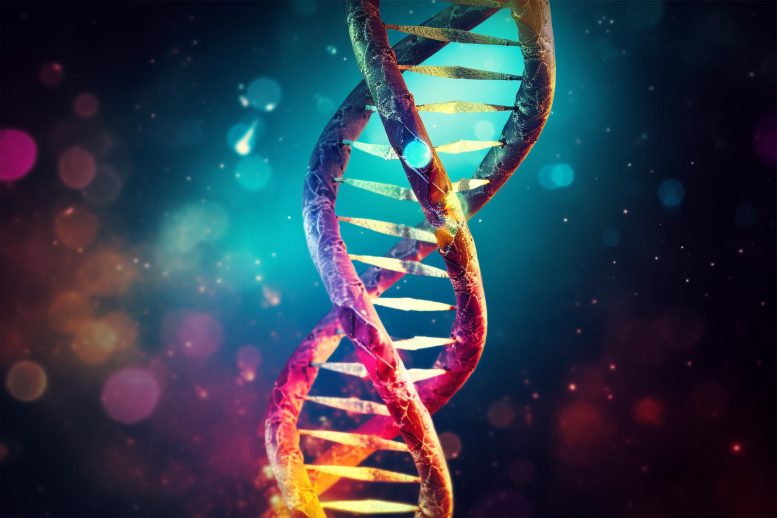
PRINT, a new gene therapy technique that uses avian-derived retrotransposons to insert entire genes into a conserved region of the human genome, offers a complementary approach to CRISPR-Cas9. Credit: SciTechDaily.com
Retrotransposons can insert new genes into a „safe harbor” in the genome, complementing CRISPR gene editing.
The recent green light for CRISPR-Cas9 therapy for sickle cell disease underscores the effectiveness of gene editing technologies in disabling genes to cure inherited diseases. However, the ability to integrate entire genes into the human genome is an alternative to false or harmful ones.
A new technique that uses a retrotransposon from birds to insert genes into the genome holds great promise for gene therapy because it inserts genes into a „safe harbor” in the human genome that does not disrupt essential genes or lead to cancer.
Retrotransposons, or retroelements, fragments DNA That, when copied RNA, code for enzymes that copy the RNA back into DNA in the genome—a self-serving cycle that clutters the genome with retrotransposon DNA. About 40% of the human genome is made up of this „selfish” new DNA, although most of the genes are turned off, called junk DNA.
A new technique called precision RNA-mediated insertion, or PRINT, exploits the ability of some retrotransposons to efficiently insert entire genes into the genome without affecting other gene functions. PRINT will complement the recognized ability of CRISPR-Cas technology to silence genes, create point mutations, and insert short stretches of DNA.
A description of PRINT, developed in the lab of Kathleen Collins, a professor of molecular and cell biology at the University of California, Berkeley, was recently published in the journal Natural Biotechnology.
PRINT involves inserting new DNA into a cell using delivery methods used to carry CRISPR-Cas9 into cells for gene editing. To print, part of the delivered RNA encodes a common retroelement protein called the R2 protein, which contains several active components, including a nickase – an enzyme that binds and nicks double-stranded DNA – and reverse transcriptase RNA, an enzyme that makes DNA copies. The other RNA is the template for the insertion of the transgene DNA, and the gene expression control elements — the fully autonomous transgene cassette — that the R2 protein inserts into the genome, Collins said.

Retrotransposons found in the genomes of the white-throated sparrow and zebra finch have been shown to safely shepherd transgenes into the human genome, providing a gene therapy approach to CRISPR-Cas9 gene editing. Credit: Briana Van Treeck, UC Berkeley
A major advantage of using the R2 protein is that it inserts the transgene into a region of the genome that contains hundreds of identical copies of the same gene—each coding for ribosomal RNA, the RNA machinery that converts messenger RNA (mRNA) into protein. With multiple redundant copies, when the insertion disrupts one or a few ribosomal RNA genes, loss of genes is not missed.
Placing the transgene in a safe harbor avoids the major complication of inserting transgenes through a human Virus The vector, which is the most common method today: the gene is inserted into the genome often at random, turning off working genes or disrupting the regulation or function of genes, leading to cancer.
„A CRISPR-Cas9-based approach can correct a mutated nucleotide or a small patch of DNA — a sequence correction. Or you can knock out a gene function with a site-directed mutation,” said Collins, who holds the Walter and Ruth Schubert Family Chair. „We're not knocking out a gene function. We're not correcting an endogenous gene mutation. We're taking a complementary approach, which is putting an autoexpressed gene that makes an active protein into the gene—readding the functional gene as a deficient bypass. It's transgene addition rather than mutation reversal. The same It is ideal for correcting loss-of-function diseases arising from the panophily of individual mutations in the gene.”
'Real winners come from birds'
Many inherited diseases, such as cystic fibrosis and hemophilia, are caused by different mutations in the same gene, all of which disable the function of the gene. Any CRISPR-Cas9-based gene editing therapy must be tailored to an individual's specific mutation. Gene recombination using PRINT can deliver the correct gene to each individual with the disease, allowing each patient's body to make a normal protein regardless of the original mutation.
Many academic labs and startups are exploring the use of transposons and retrotransposons to insert genes for gene therapy. A popular retrotransposon under study by biotech companies is LINE-1 (long interspersed element-1), which has duplicated itself and some hitchhiker genes to cover 30% of the genome in humans, although less than 100 of our genome's LINE-1 retrotransposons. Duplicates are functional today, a small part of the genome.
Collins, along with UC Berkeley postdoctoral colleagues Akanksha Dhavani and Eva Nogales, UC Berkeley Distinguished Professor in the Department of Molecular and Cell Biology and Howard Hughes Medical Institute Investigator, published the cryo-electron microscopy structure of the retrograde protein-1 enzyme. Magazine on December 14 Nature.
That study made it clear, Collins said, that the LINE-1 retrotransposon protein would be difficult to engineer to safely and efficiently insert a transgene into the human genome. But previous research demonstrating that genes inserted into the repetitive, ribosomal RNA coding region of a gene (rDNA) generally suggested to Collins that a different retroelement, called R2, works best for safe transgene insertion.
Because R2 is not found in humans, Collins and senior researcher Xiaozhu Zhang of UC Berkeley and postdoctoral fellow Brianna Van Drijk discovered R2. A version that targets rDNA regions in the human genome and is efficient at inserting long stretches of DNA into the region.
„After chasing dozens of them, the real winners came from the birds,” Collins said, including the zebra finch and the white-throated sparrow.
Although mammalian genomes lack R2, they contain binding sites required for R2—a possible indication that mammalian ancestors had an R2-like retroelement that somehow got kicked out. Mammalian genome.
In the experiments, Zhang and Van Drijk combined the mRNA-encoding R2 protein and a template RNA to form a transgene with a fluorescent protein expressed by an RNA polymerase promoter. These were transformed into cultured human cells. Half of the cells glow green or red due to fluorescent protein expression under laser light, demonstrating that the R2 system has successfully inserted a working fluorescent protein into the genome.
Further studies showed that the transgene actually inserts into the rDNA regions of the genome and can insert about 10 copies of the RNA template without disrupting the protein-producing function of the rDNA genes.
A giant ribosome biosynthetic center
Insertion of transgenes into rDNA regions of the genome is advantageous for reasons other than providing a safe harbor. The rDNA regions are found on the flat arms of five separate chromosomes. All of these stubborn arms come together to form a structure called the nucleolus, where DNA is converted into ribosomal RNA, which folds into the ribosomal machinery that makes proteins. Within the nucleolus, rDNA transcription is highly regulated, and genes undergo rapid repair because any broken rDNA, left to propagate, can stop protein production. Consequently, any transgene inserted into the rDNA region of the genome will be treated with kit gloves inside the nucleolus.
„The nucleolus is a giant ribosome biosynthetic center,” Collins said. „But it's a very privileged DNA repair environment that has a low oncogenic risk from gene insertion. It's brilliant that these successful retroelements—I'm anthropomorphizing them—went into ribosomal DNA. It's multicopy, it's conserved, and it's in the sense that you can disrupt one of these copies and the cell doesn't care. is a safe harbor.
This makes the region an ideal location for gene insertion for human gene therapy.
Collins acknowledged that much is still unknown about how R2 works, and questions remain about the biology of rDNA transcription: How many rDNA genes can be disrupted before the cell notices? Since some cells turn off many of the 400+ rDNA genes in the human genome, are these cells more susceptible to PRINT's side effects? She and her team are investigating these questions, but PRINT modifies various proteins and RNAs involved in retroelement insertion to function better in cultured cells and primary cells from human tissues.
Still, the bottom line is, „it works,” he said. „We need to understand a little more about the biology of our rDNA to really take advantage of it.”
Reference: Xiaozhu Zhang, Briana Van Treeck, Connor A. Horton, Jeremy JR McIntyre, Sarah M. Palm, Justin L. Shumate and Kathleen Collins, February 2020, 2020 2020 , Natural Biotechnology.
DOI: 10.1038/s41587-024-02137-y
Other co-authors Natural Biotechnology UC Berkeley graduate students Connor Horton, Jeremy McIntyre, Sarah Baum and Justin Shumate. He supported the work National Institutes of Health (F32 GM139306, DP1 HL156819, T32 GM07232) and the Shirley and Kay Kersey Foundation. Collins has applied for a patent on PRINT and co-founded Addition Therapeutics to develop PRINT into a further gene therapy.

„Oddany rozwiązywacz problemów. Przyjazny hipsterom praktykant bekonu. Miłośnik kawy. Nieuleczalny introwertyk. Student.
